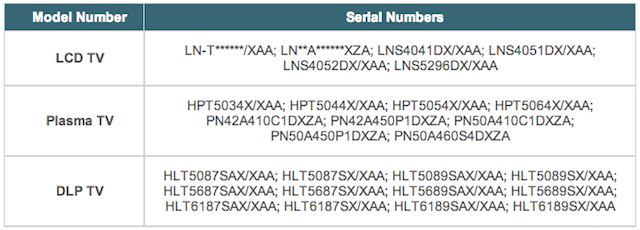
The clicking began this summer. I purchased a 55-inch Samsung LCD television a few years ago for a not inconsiderable amount of money, which I justified to myself—and to my wife, who followed the "42 inches should be enough for anybody" principle—by noting that the TV would last for years, no doubt providing the decades of service seen from many of the old CRT televisions and probably ending up as an heirloom which would be passed down to our children until it one day ended up on the 2095 version of Antiques Roadshow, astonishing the nation with the fact that it still looked great displaying 1080p video.
The clicks gave me doubts. Powering on the TV would make it click once, pause, then click again as though something inside were cycling, before it eventually sprang to glorious life. After a few weeks, turning on the TV took three clicks. Within a month, we were up to five. Last week, it hit seven.
As the startup delays grew longer and the clicks escalated, I began to fear that my expensive purchase would soon not function at all. A repair bill likely loomed in my future, and if past TV repair experience was anything to go on, I would probably end up spending a hundred bucks for a technician to come out only to find that he couldn't fix the problem. Would I have to buy a new TV?
Click, click

I Googled the Samsung "click of death" in the hope, however remote, that it was a common issue and could be solved by some sort of do-it-yourself voodoo. I was half right. The problem was well-known, and well-complained about online, but the fix involved plucking key capacitors out of the unit and replacing them. I used to play with breadboards and built simple circuits when I was a kid, but there was just no way I was messing around with the internals of my 55-inch TV. Others aren't so skittish—and this can indeed be done yourself if you're comfortable with a soldering iron.
Then I came across a link with news I had missed when it happened earlier this year: Samsung had actually been hit with a class-action lawsuit in Oklahoma City over this very issue and had settled it in spring. Class-action settlements are notorious for providing almost worthless benefits to those affected but huge paydays for the lawyers (case in point: the $7.80 check I randomly received in the mail last week for some "AT&T DSL Speed Settlement" in which the lawyers made $500,000). But in this case, the settlement benefits were quite real. I had only to call a toll-free phone number and Samsung said that it would send out a local repair tech free of charge to replace a set of capacitors on the TV's power supply. (If you have already paid for such a repair, Samsung will reimburse you.)
The offer only applies to symptoms "such as not turning on, experiencing a significant delay in turning on, making a clicking sound, cycling on and off, or other similar problems," and it only applies to a set of specific models manufactured before December 31, 2008. I ran downstairs with laptop in hand to compare the list to the small sticker on the back of my TV set. The numbers matched. I called the phone number on a Saturday morning and was done within five minutes. A technician from a reputable local company showed up at my door Monday morning, we took the TV off its stand and laid it face down on the floor, and he opened it up and began surgery.
He told me that the issue was a common one in flat panel TVs and was actually keeping him in business. (Samsung has said that the problem affected "approximately one percent of Samsung televisions sold in the US from 2006 to 2008.") Pulling off the back of the TV set and exposing the power supply, he found that seven of the capacitors used to store up enough charge to light the fluorescent backlight had "bubbled" tops, indicating part failure. (Update: a reader tells me that my blown 25V capacitors must have done some other job instead, as they aren't powerful enough to zap a backlight, which needs ridiculously high voltages to start and which is usually powered by a transformer.)
"I'm surprised you even got this thing to turn on," he told me.
He replaced nine of the capacitors with 25V 1000µf capacitors just to be safe and closed the TV back up. When we tested it, the TV lit on its first click.
The home visit, parts, and labor would have run me nearly $300, and the TV was out of warranty. Samsung has denied the claims in the Oklahoma City lawsuit, but to its credit it did agree to take care of the problem (and did so even before the settlement was reached). And, at least in my case, it did so in an absolutely painless way. My technician walked out the door without me paying a cent. The experience was positive enough that the dark thoughts I had been harboring–"I am never buying a Samsung product ever again!"–faded a bit, just as they did when Microsoft replaced my "red ring of death" Xbox 360 with no questions asked.
Still, it felt like a near-death experience for my $2,000 piece of hardware. While it's working fine again now, I keep wondering how long I have until the next design flaw blows out some tiny component.

If you live in the US and have a Samsung TV displaying one of the "Covered TV Symptoms," you have 18 months from March 2, 2012 to file a claim. The phone number to do so is 1-888-899-7602.
reader comments
139